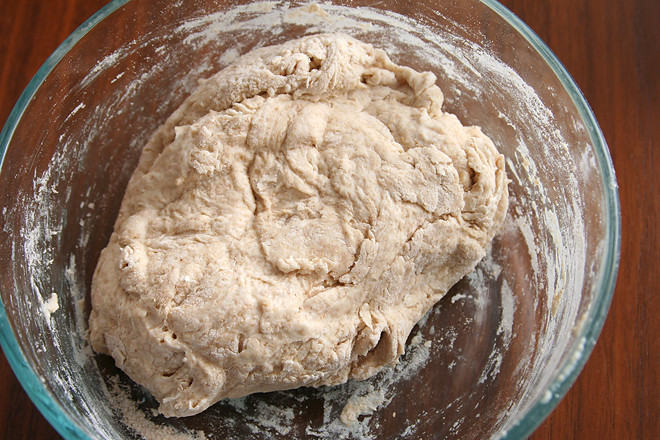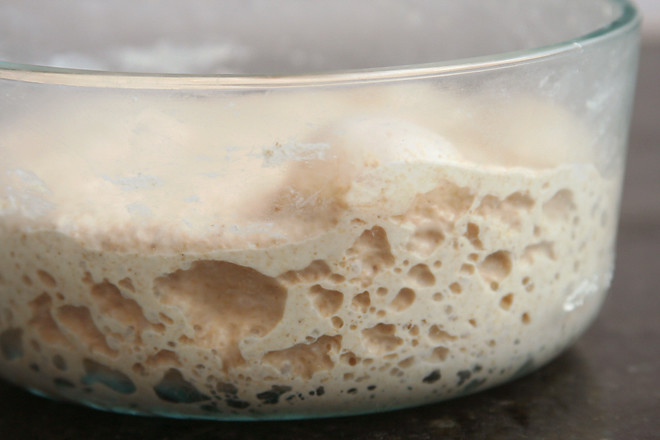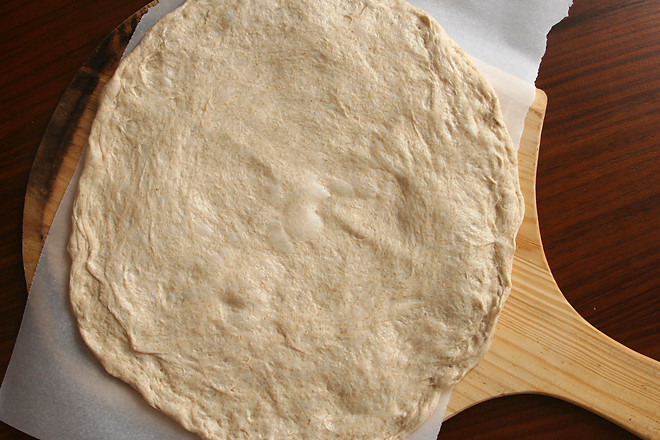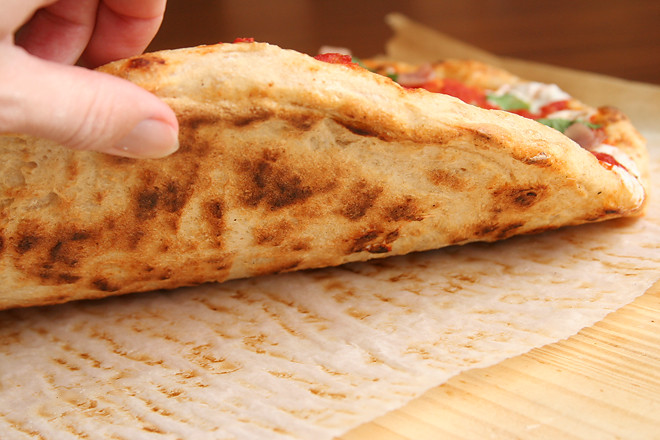Since I make pizza once every two weeks or so, it’s only natural that my dough recipe has evolved over the years. The recipe I’ve been using lately doesn’t bear much resemblance to my favorite from several years ago beyond the obvious flour, water, and yeast. My current favorite couldn’t be easier to make – with a few caveats.
The first is that it’s best if you think ahead – far ahead, if you can. I usually mix the dough on Monday night to cook it on Friday night. That being said, if I didn’t decide I wanted pizza until Thursday, I’d still use this recipe, with just a one-night rest.
The second is that I’m using flour I special-ordered from Italy. I’ve entered the deep end, where flour for pizza is no longer taken out of the grocery budget, it comes out of my fun money allowance. But then I tried the recipe with bread flour (King Arthur), and to be honest, it was so good that it doesn’t seem like the special flour is worth the splurge.
So, thinking in advance helps, and fancy flour might help, but after that, it’s just mixing up flour, water, yeast, sugar, and salt. I don’t bother with a whole wheat pre-dough; I just use half whole wheat flour in the dough, and the long wait in the fridge is plenty of time to soften the grains. I also don’t put much effort into kneading the dough. I mix it, put it in the fridge overnight, and spend a minute or two kneading it once it’s evenly hydrated. If you’d rather do all the work up front and forget about it for a few days, you can just knead it longer right after you mix it up.
Then it sits in the back of the fridge until I’m ready for it at the end of the week. I come home from work on Friday, take the dough out to warm up, and go sit in my favorite chair with a book and my cat. An hour or two later, somewhat refreshed, the dough is easy to stretch out to a circle and ready to top.
Another pizza splurge I indulged in last year was a Baking Steel. It does make homemade pizza better, and I recommend it, but of course a pizza stone will do a fine job too. With the Baking Steel, it gets so hot that the dough crisps and browns within a few minutes, so I put it on a high rack and turn the broiler on when the pizza goes in. This is not recommended with a stone, since the direct heat could cause it to crack (heck, in my experience, anything causes them to crack!).
And then you’ve got pizza as good as you can get with a home oven. The bottom is crisp and browned, the middle is full of bubbles, the dough has great flavor on its own, even without whatever delicious toppings you pile on top. I’ve been making this new favorite for almost a year, and I have no plans to change it up – but you never know. There’s always something new to try, so maybe in a few years, I’ll be sharing yet another new and improved pizza method.
Printer Friendly Recipe
Slow Ferment Pizza Dough (adapted from Serious Eats’ Cold-Fermented Pizza Dough)
I’ve reduced the yeast from Kenji’s recipe, because with the full amount, my fermented dough was developing an unpleasant sour aroma.
Whether baking on a steel or a stone, I’ve found that the dough is easiest to transfer to the oven with parchment paper, but it crisps and browns better if the paper is removed once the dough sets. Furthermore, a baking steel is hot enough to burn the paper after a couple minutes in the oven, creating a mess.
10 ounces (2 cups) bread flour or 00 flour
10 ounces (2 cups) whole wheat flour
2 teaspoon salt
⅔ teaspoon yeast
½ teaspoon sugar
1¾ cups water
1. In a medium bowl, combine all of the ingredients until there are no dry bits remaining. Tightly cover and store in the refrigerator, at least overnight or up to 5 days. The following day, knead the dough for about a minute, until it’s smooth and elastic. Cover and refrigerate. (Alternatively, the dough can be kneaded for about 5 minutes right after mixing, with no additional kneading necessary.)
2. About two hours before baking, remove the dough from the refrigerator. Use a dough scraper or rubber spatula to transfer the dough from the bowl to a damp dishtowel or a lightly floured surface. Use a knife to divide the dough in half. Shape each portion into a ball. Cover the dough balls loosely with plastic wrap; leave at room temperature for 1½ to 2 hours, until the dough is easily stretched.
3. About 45 minutes before baking the pizzas, place a baking steel (about 6 inches from the broiler) or pizza stone (lowest rack) in the oven; heat the oven to its hottest setting. Line a pizza peel or the back of a baking sheet with parchment paper.
4. Stretch one portion of dough to a 10- to 12-inch round; lay it on the parchment paper. If necessary to even out thick areas and fix the shape of the dough, pull the edges to an even circle. Top with desired toppings.
5. Transfer the pizza on the parchment paper to the heated steel or stone. If using a steel, immediately turn the oven off and the broiler on to its hottest setting. After 1 minute, use a metal spatula to lift the pizza while using tongs to remove the parchment paper. Continue cooking until the cheese is bubbling and the bottom of the crust is spottily browned, about 4 additional minutes for a baking steel or 6-7 minutes for a baking stone. Use the metal spatula and pizza peel to remove the pizza from the oven and transfer it to a cooling rack. Cool for about 5 minutes before cutting and serving. Repeat with the remaining dough.















I love making my own pizza, but have only gone as far as to leave the dough to prove overnight in the fridge. Your recipe I must try!! Bread and pizza dough are so many ch better when they are allowed to develop their flavours. Instead of being a carrier they contribute to the dish. Thank you for the recipe. Sammie.
is it possible to halve this recipe? it’s just the 2 of us, my husband and i, and one pizza is really all we need. is there some sort of “critical mass” involved where you must use at least 4 cups of flour? also, can this be done with all king arthur bread flour and no whole wheat? nothing against whole wheat flour… well, yes, i really don’t like it, so i guess i do have something against it. thanks for any help!
auntie beak – Confession: I have never made the full recipe, I always halve it. It works great. And yes, you can definitely use all white flour. However, I wish I could make it for you with the WW flour – I swear you’d never know it’s there! 🙂
thanks so much for your reply! i would use ww flour if i had any, but i don’t even have any. okay, maybe i’ll buy a small bag and try it out.
auntie beak – If you can find a small bag (not always easy with flour), you could start with a quarter WW flour instead of half if you’re worried. My favorite WW flours, for what it’s worth, are King Arthur and Trader Joe’s white whole wheat flour. They both seem to be milled finer, so they blend in to the dough better. However, with such a long cold-ferment time, even larger grains will soften and be unnoticeable.
I plan to try your recipe with my sourdough starter instead of commercial yeast. It looks like a great recipe and it’s very convenient; thank you for sharing it.
You call for 2/3 teas of yeast .. I usually get yeast in the pkg .. how many pkg will i need?
Thank you can’t wait to make this !!
Connie – One packet is 2 1/4 teaspoons, so you’ll only need a small portion of one packet.
If using a stone do you turn oven off and broiler on it wasn`the clear at least to me how to proceed with a stone. I have never used one so wanted to verify the process.
I have a query
Which part of the refrigerator should I rest the dough in?
The top-part, where ice-cream is stored, or the bottom-part, where food & vegetables r kept?
Stella – If using a stone, keep the oven on at its highest temperature while the pizza cooks. Do not use the broiler, which could cause the stone to crack.
Purnendu – Where food and vegetables are kept.
Italian flour needs the high temps common in European ovens or wood fired pizza places. Without the heat it never gets to show its strengths. Bread dough is cheaper, just as good and has a nicer presentation as it burns a bit.